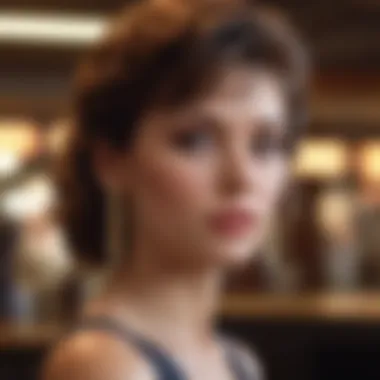Exploring the Iconic Films of the 1980s


Intro
The 1980s stand as a pivotal period in the film industry, characterized by notable innovations and shifting audience dynamics. This decade did not just produce memorable films; it reshaped the landscape of cinema as we know it today. Here, the incorporation of advanced special effects, the rise of blockbuster franchises, and the emergence of diverse genres marked a significant evolution in storytelling.
In this overview, we will navigate the key trends that emerged in 1980s cinema, shedding light on influential movements, standout directors, and the films that left an indelible mark on both the industry and popular culture. Understanding this decade's cinematic output enables us to appreciate the foundations of modern filmmaking and viewing experiences.
The analyses will extend beyond just titles and box office successes; they will also dive into the thematic concerns and societal reflections embedded within the films of this era. Each film serves as a lens through which we can view the shifting preferences of audiences, as well as the broader cultural landscape of the time.
Preface to the 1980s in Cinema
Understanding the 1980s in cinema requires a look at various dimensions that shaped films during this period. This decade was not just about entertainment; it reflected broader societal shifts, technological progress, and the evolving tastes of audiences. The importance of this exploration lies in grasping how films offered a mirror to the cultural landscape and influenced future cinematic trends.
Cultural Context of the 1980s
The 1980s were marked by significant cultural changes across the globe. The rise of consumerism influenced lifestyle, fashion, and media. Films became a means of escapism, appealing to the desire for adventure and fantasy. The youth culture gained prominence, leading to a surge in teen-oriented films. Movies reflected the growing concerns regarding issues such as nuclear war, economic disparity, and social progression. The significance of the decade's films extends beyond entertainment; they encapsulated the anxieties and aspirations of society.
Technological Advancements in Filmmaking
The technological landscape of filmmaking evolved notably during the 1980s. The introduction of advanced special effects techniques transformed how stories were told on screen. Innovations like computer-generated imagery (CGI) began to take root, paving the way for future blockbusters. Filmmakers embraced new editing technologies which allowed for more dynamic storytelling. Sound design also improved significantly, as films aimed to create immersive experiences that resonated with viewers on multiple levels.
The Role of Blockbusters
The emergence of blockbusters fundamentally changed the film industry. Movies like "E.T. the Extra-Terrestrial" and "Star Wars: The Empire Strikes Back" dominated box offices and redefined what success meant in cinema. These films used extensive marketing campaigns to create anticipation and excitement, transforming them into cultural phenomena. The blockbuster model proved lucrative, leading studios to prioritize high-budget productions that appealed to mass audiences. This era not only influenced production strategies but also directly affected how stories were written and marketed, setting trends that persist in modern cinema.
"The 1980s showcased how cinema could intersect with the cultural zeitgeist, using its platform to address profound questions while entertaining millions."
The foundational elements discussed above are crucial to understanding the cinematic revolution of the 1980s. They serve as a testament to the decade’s impact on film as an art form and its ability to shape and reflect societal narrative.
Prominent Directors of the 1980s
The 1980s marked a distinct period in the cinematic landscape, characterized by the emergence of visionary directors who significantly influenced filmmaking. These prominent directors shaped genres and created memorable narratives. It's crucial to explore their contributions, as their work laid the groundwork for the evolution of modern cinema. Each brought unique perspectives, aesthetic choices, and storytelling techniques that resonate today.
Steven Spielberg: The Master of Blockbusters
Steven Spielberg stands as a titan of the 1980s film industry. His ability to craft compelling narratives, often infused with adventure, humor, and a dose of nostalgia, struck a chord with audiences. With films like E.T. the Extra-Terrestrial and Indiana Jones: Raiders of the Lost Ark, Spielberg became synonymous with blockbuster filmmaking. His innovative use of special effects, combined with emotionally resonant storytelling, transformed the way films were made and received.
Spielberg's commitment to storytelling was evident in his focus on character development. He understood the importance of emotional connection in films. His work in the 1980s influenced not just box office trends but also how future filmmakers would approach narratives. He created a template for the blockbuster that continues to be followed today.
Woody Allen and the Rise of Introspective Cinema
In contrast to Spielberg's grand epics, Woody Allen directed films that delved into the complexities of human relationships and inner thoughts. Movies like Annie Hall showcased his unique style of comedy, which blended humor with a profound introspection about love and identity. Allen's narratives often featured neurotic characters navigating life's absurdities.
His focus on dialogue-driven stories set a precedent for films that prioritize character exploration over action. This approach influenced a generation of filmmakers who sought to explore the human condition in nuanced ways. Allen's films reflected the cultural and social contexts of the time, proposing self-examination and philosophical pondering in a rapidly changing world.
Ridley Scott and Science Fiction Innovations
Ridley Scott made significant contributions to the science fiction genre during the 1980s, introducing innovative visual storytelling techniques. His work in films like Blade Runner revolutionized sci-fi aesthetics, blending noir elements with futuristic themes. Scott’s meticulous attention to detail created immersive worlds, prompting audiences to confront complex societal issues.
Blade Runner is noted for its philosophical questions about humanity and technology. Scott's films encouraged viewers to think critically about the implications of advancements in technology, a topic that remains relevant today. His ability to weave deep narrative layers into visually stunning films set a standard for science fiction filmmakers seeking to provoke thought while entertaining.


"Directors like Spielberg, Allen, and Scott not only shaped the aesthetic of their films but also influenced the themes and ideas that continue to permeate movie making today."
In summary, the contributions of these prominent directors during the 1980s remain pivotal in understanding the development of modern cinema. Each director brought a unique voice and vision, enhancing the diversity of storytelling in film.
Noteworthy Films that Shaped the Decade
The 1980s brought a remarkable transformation in cinema. This period was not only characterized by blockbuster hits but also by films that impacted society and culture. The noteworthy films of this era reflect the complexities of the time, resonating with audiences on multiple levels. By examining these films, we can uncover the trends and themes that defined a generation.
The Impact of Star Wars: The Empire Strikes Back
Star Wars: The Empire Strikes Back, released in 1980, is often regarded as one of the greatest films in cinematic history. Its success can be attributed to innovative storytelling and groundbreaking special effects. The narrative deepens the conflicts established in the original Star Wars, elevating the stakes for its characters. This film introduced a darker tone and complex character dynamics, particularly through the character of Darth Vader, who became an iconic figure in film lore.
The film's impact resonates beyond just entertainment. It contributed significantly to the expansion of the science fiction genre and launched a franchise that continues to thrive today. The techniques used in the filmmaking process influenced numerous subsequent films, setting a high standard for visual effects. The cultural footprint of The Empire Strikes Back exemplifies how one film can shift audience expectations and inspire creativity across the industry.
The Social Significance of E.T. the Extra-Terrestrial
Released in 1982, E.T. the Extra-Terrestrial is a hallmark of family cinema that highlights themes of friendship and innocence. Directed by Steven Spielberg, the film follows the story of a young boy named Elliott and his relationship with a stranded alien. The simplicity and sincerity of the narrative struck a chord with audiences, making it emotionally powerful.
Beyond its heartwarming plot, E.T. also serves as a commentary on societal issues. It subtly addresses themes of childhood and the disruption of family through the lens of an extraterrestrial encounter. The film's portrayal of alienation and compassion encourages viewers to reflect on their own relationships. The film was a box office success, further solidifying Spielberg's standing as a leading filmmaker of the decade while leaving a legacy that resonates with viewers today.
The Cultural Phenomenon of The Breakfast Club
Released in 1985, The Breakfast Club stands as a defining film of the teen-centric genre. Directed by John Hughes, the film brings together five high school students from different social backgrounds who are forced to spend a Saturday in detention. As they engage in open dialogue, they confront their stereotypes and reveal their true selves.
The film's significance lies in its exploration of adolescent identity and the pressures faced by teenagers. Each character embodies distinct social archetypes, allowing for a relatable narrative that resonates with many. The Breakfast Club presents an honest look at the struggles of youth, making it a cultural touchstone. Its themes of acceptance and understanding remain relevant, influencing countless films and discussions about teenage life.
The Enduring Legacy of Back to the Future
Back to the Future, released in 1985, is celebrated for its inventive premise that combines science fiction with comedy. Directed by Robert Zemeckis, the film features Marty McFly, who travels back in time to the 1950s. The clever writing, engaging plot, and memorable characters have made this film a classic.
Beyond entertainment, Back to the Future examines the concept of time and its impact on identity and choices. The film encourages audiences to reflect on their past and consider how it shapes their present. The effects of this film continue to be felt, not just in sequels and spinoffs but in its influence on the genre. Its ability to entertain while provoking thought about time travel has cemented its legacy in film history.
"These films not only entertained audiences but also shaped the cultural landscape of the time. Their themes and narratives continue to influence filmmakers and audiences alike, proving the power of cinema to reflect societal values."
Genres and Their Evolution
The 1980s was a transformative decade for cinema, marking a significant shift in genres. Genres and their evolution in this period shaped audience experiences and expectations. Understanding these shifts gives insights into the changing landscape of filmmaking. Each genre adapted to cultural contexts, leveraging technological advancements and audience preferences.
The exploration of genres is important because it reveals how filmmakers responded to social changes. For example, inequalities and youth culture became central themes in many films. In this sense, genres were not static; they evolved, reflecting and influencing societal norms.
The Rise of Action Films
Action films surged in popularity during the 1980s. This genre leveraged adrenaline-pumping sequences and iconic heroes, establishing a new standard. Films like "Die Hard" and "Rambo: First Blood" became cultural touchstones. Audiences were drawn in by spectacular stunts and visual impacts, such as explosions and hand-to-hand combat.
The action genre also introduced strong protagonists. Characters like Bruce Willis's John McClane became symbols of resilience and determination. These films often featured lone heroes battling against larger systems, which resonated with audiences experiencing societal and political unrest.
- Popular elements included:
- High-paced chases
- Intense fight scenes
- Dramatic plot twists
As these films progressed, production techniques advanced. Directors and cinematographers experimented with new technologies, like practical effects and choreographed fights, enhancing viewing experiences.


The Expansion of Horror Cinema
Horror films also experienced significant changes. The 1980s saw the rise of slasher films, which explored the darker aspects of the human psyche. Titles like "A Nightmare on Elm Street" and "Friday the 13th" captivated audiences. These films provided a form of social commentary, often addressing fears about violence and moral decay.
Horror became a space for innovation regarding themes and narratives. Many films used suspense and psychological elements to engage viewers. The character of Freddy Krueger, for instance, intricately combined horror and dark humor, challenging traditional tropes of the genre.
Horror films diverged into different sub-genres, including:
- Supernatural horror
- Psychological thrillers
- Satirical horror
The variety made horror films accessible to a broader audience, exploring fear in diverse ways.
The Growth of Teen-centric Films
Teen-centric films emerged as a significant genre in the 1980s. This genre resonated with a generation grappling with identity issues. Movies like "The Breakfast Club" and "Ferris Bueller's Day Off" captured the essence of youth, highlighting the struggles and joys of teenage life.
These films often combined humor and drama. They addressed themes such as friendship, love, and societal expectations. The characters represented various archetypes, allowing viewers to relate to their struggles and triumphs.
Teen films shifted perceptions of young people in cinema. They moved away from clichés, instead presenting authentic narratives. This evolution influenced contemporary storytelling, as more filmmakers began to focus on intrinsic character development and nuanced plots.
To conclude, the evolution of genres during the 1980s significantly impacted cinema. This decade not only pushed technical boundaries but also changed narratives, addressing pressing societal issues. By analyzing these genres, we recognize their importance within the broader tapestry of film history.
Box Office Trends and Audience Preferences
The box office trends and audience preferences in the 1980s represent a pivotal shift in the landscape of cinema. This era witnessed a transformation in how audiences engaged with films, driven by both demographics and evolving societal norms. The significance of these trends cannot be understated in understanding how the decade's films made their mark.
In the early 1980s, the film industry began to target broader audiences, moving beyond niche markets. This shift was characterized by the emergence of blockbuster films that sought to appeal to diverse demographics. Films such as Star Wars: The Empire Strikes Back and E.T. the Extra-Terrestrial brought families to theaters in droves, and their success influenced studio strategies moving forward.
The prevailing cultural values of the time, including a growing interest in youth culture, heavily impacted the types of films that gained popularity. The rise of action-packed narratives attracted a younger audience, while comedies and dramas were marketed to more mature viewers. By analyzing box office successes, it becomes clear how these preferences molded the production landscape, encouraging studios to cater to the desires of various age groups.
Shift in Target Audiences
The 1980s marked a defining moment for the shift in target audiences in cinema. With demographic changes and evolving societal themes, filmmakers adjusted their approaches to reach larger swathes of viewers. A notable aspect of this shift was the increased focus on youth culture. The influences of the Baby Boomer generation, now coming into maturity, dictated cinematic themes that related to personal growth, rebellion, and social change.
Films like The Breakfast Club exemplified this new focus. It resonated with young adults by reflecting their struggles. This understanding of the teenage experience captured a demographic many filmmakers had previously overlooked. However, it was not only teenagers who were courted for box office success; the family-friendly explorations in E.T. appealed notably to the entire family unit, creating multigenerational interest in cinema.
In stark contrast, the anxiety of the Cold War era prompted films that addressed adult themes, notably in movies such as Platoon which reflected on the Vietnam War. The duality of the audience focus—entertaining youth while addressing adult conflict—became a staple of 1980s cinema, demonstrating filmmakers' adaptability and awareness to audience preferences.
The Influence of Home Video
The advent of home video fundamentally altered the film economy in the 1980s. As VCRs became affordable and popular, the way audiences consumed films transformed significantly. Movies were no longer confined to the theater; they could now be enjoyed in the comfort of one's home at any time. The implications were profound not just for audiences but for the entire film industry.
Home video introduced a new revenue stream for studios, complementing box office returns with rental fees from video stores. This led to a relaxation of the traditional release windows. A film that flopped at the box office could find new life on video. Noteworthy titles such as Ghostbusters became cultural phenomena at home, as families would gather to watch movies frequently.
Moreover, the home video boom enabled audiences to revisit films multiple times, further solidifying the connection to their favorite titles. This behavior influenced how films were marketed. Trailers and promotional materials became essential for home video releases, shaping marketing strategies that targeted home audiences directly.
Furthermore, the ability to watch films repeatedly facilitated a deeper engagement with cinematic themes, characters, and narratives. Filmmakers, aware of this changing landscape, began to craft stories that were not only entertaining for a single viewing but also rewarding for repeat viewings.
The 1980s brought critical changes in the way films were produced and consumed. This era laid the groundwork for modern filmmaking, with lasting effects that resonate in today's cinematic landscape.
Cinematic Techniques and Innovation


The 1980s was a transformative era for cinema, where cinematic techniques and innovation paved the way for storytelling that resonated deeply with audiences. Not only did filmmakers push boundaries, but they also set standards that would become part of modern filmmaking. Key advancements in cinematic techniques have provided the foundation for many of today’s visual styles and narrative structures.
Advancements in technology during this time brought about a revolution in how stories could be portrayed on screen. Innovative methods such as enhanced special effects allowed filmmakers to bring fantastical elements to life, engaging viewers like never before. The use of innovative editing techniques further allowed for more dynamic storytelling, creating pacing and rhythm that matched the themes of films. These elements are critical, as they connected audiences to the narratives being told, making for a more immersive experience.
Special Effects Revolution
The special effects revolution of the 1980s was characterized by the marriage of creativity and technology. Films like Star Wars: The Empire Strikes Back and E.T. the Extra-Terrestrial showcased effects that previously seemed impossible. This decade saw the introduction of groundbreaking techniques, such as computer-generated imagery (CGI) and advanced practical effects. The use of miniatures, matte paintings, and animatronics became refined, allowing for greater realism in films.
Special effects also opened new avenues for storytelling. Audiences were drawn to the spectacle of fantasy worlds and elaborate action sequences. For instance, the innovative use of special effects in Back to the Future enhanced the storytelling by enabling time travel elements to become visually captivating. These advancements not only entertained but also inspired future filmmakers to explore new creative dimensions in their projects.
"The blend of practical effects with burgeoning digital techniques in the 1980s revolutionized how narratives could be presented on screen."
Editing Techniques that Defined the Era
Editing in the 1980s underwent significant changes that impacted narrative structure and audience engagement. Editors began employing techniques like quick cuts, cross-cutting, and matched action, all of which contributed to a more dynamic viewing experience. Films like The Breakfast Club illustrated the complexities of teen life with sharp editing that mirrored the emotional highs and lows of adolescence.
The rise of video editing technology also allowed editors to experiment more with their cuts. Techniques such as slow motion and montages became widely used. These tools gave filmmakers the ability to manipulate time and perception, enhancing the emotional weight of scenes. The influence of editing is undeniable; it dictates rhythm, flow, and ultimately, how the story is perceived by the viewer.
Cultural and Social Issues Portrayed in 1980s Films
The 1980s was a decade of profound transformation in various societal aspects, which films of this era captured effectively. The cinema not only reflected popular culture but also engaged with pressing social issues. Films became a lens through which audiences could explore themes related to identity, conflict, and representation. Understanding these cultural and social issues is crucial when examining the legacy of 1980s films.
Films from this period often dealt with issues of war, race, and gender, portraying the realities and struggles faced by individuals and communities. By addressing these topics, filmmakers drew connections between personal stories and broader societal trends. This interplay contributed to the lasting impact that these films have on current dialogues surrounding these issues.
Reflections on War and National Identity
The aftermath of the Vietnam War profoundly influenced American society in the 1980s. This conflict left many questioning national identity and the country’s role on the world stage. Movies like Platoon and Full Metal Jacket surfaced, reflecting the turbulence of this era. These films delved into the psychological effects of war on soldiers while also providing commentary on militarism and masculinity.
Moreover, other films such as Rambo: First Blood and The Hunt for Red October echoed sentiments of American patriotism. Such narratives often presented military intervention as a heroic endeavor, reshaping cultural perceptions of the military and national identity.
"War is hell, but it brings people together in ways that peace sometimes cannot." The 1980s cinema articulated this tension.
Racial and Gender Representations
The portrayal of race and gender in 1980s films provides insight into the evolving dynamics of these crucial social issues. African American representation started to shift, with figures like those from Coming to America and Do the Right Thing telling more authentic and complex stories. These narratives played a role in challenging stereotypes, albeit while occasionally falling into familiar tropes.
Gender roles were also under scrutiny. Women were frequently depicted in both traditional and non-traditional roles. In films like Terms of Endearment and Alien, character arcs explored female strength, resilience, and complicity in societal expectations. The presence of strong female leads helped to push boundaries, yet the representation remained limited in some areas.
Films during this time prompted audiences to engage in conversations around race and gender, urging society to reconsider its views and biases. These films did not merely entertain; they invited reflection and criticism, contributing to broader social change.
Through dissecting the cultural and social issues present in 1980s films, we gain a deeper understanding of how cinema has the power to influence and reflect societal values. This analysis offers not only nostalgia but also essential insights into the continued quest for an equitable society.
Culmination: The Lasting Impact of the 1980s on Modern Cinema
The 1980s represented a pivotal era in film history, characterized by a blend of innovation and genre-expanding narratives. The impact of this decade reverberates through to modern cinema, shaping not only storytelling techniques but also audience expectations and industry standards. The importance of this topic lies in understanding how the media landscape transitioned during this period and how it continues to influence filmmakers today.
Central to this discussion is the balance between continuity and change in filmmaking. While many conventions established in the 1980s remain relevant, the era also heralded significant departures from traditional narratives and cinematic techniques. This tension defined 1980s films and established a legacy that modern cinema inherits.
The experimentation with special effects, particularly in blockbusters like Star Wars: The Empire Strikes Back, set new standards for visual storytelling. Audiences have since come to expect quality special effects, which are now a staple in various film genres. These advancements laid the groundwork for the digital effects we now commonly see in films.
Additionally, the films of this decade often tackled social themes, including national identity, race relations, and gender roles. This focus on relevant issues fostered a more engaged audience and encouraged filmmakers to explore deeper societal themes. Because of films like E.T. the Extra-Terrestrial and The Breakfast Club, contemporary cinema now often incorporates a balance of entertainment and message, allowing viewers to connect with both the characters and the context in which they exist.
"The 1980s crafted a framework for filmmakers that is evident in the narratives we see today, reinforcing the idea that cinema not only entertains but also reflects societal dynamics."
Furthermore, the 1980s established the blockbuster as a central economic force in Hollywood. These films became cultural touchstones, cultivating a collective experience among audiences, which remains a significant aspect of film marketing today. The idea that a movie can dominate box office sales and create a community among fans continues to inform how films are produced and distributed.
In summary, the lasting impact of the 1980s on modern cinema is multifaceted. It combines the advancements in technology, narrative complexity, and a greater focus on social issues. Together, these elements have altered the very fabric of filmmaking, creating an intricate tapestry from which contemporary cinematic works draw inspiration. Recognizing these connections allows us to appreciate not only the films of the past but also the evolving nature of storytelling in visual mediums.



